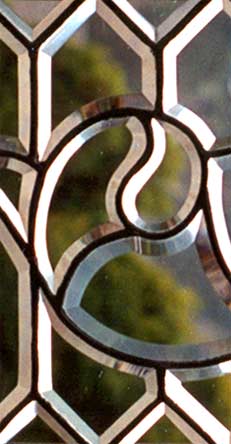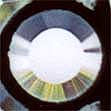 A Beveled Glass window is made of numerous pieces of clear plate glass which
have had all their edges ground and polished at a specific angle. The angled
edges, or bevels, cause transmitted light to be prismatically refracted,
often creating rainbow-like color effects. In both transmitted and reflected
light conditions, the beveled angles cause light to create wonderful visual
displays.
A Beveled Glass window is made of numerous pieces of clear plate glass which
have had all their edges ground and polished at a specific angle. The angled
edges, or bevels, cause transmitted light to be prismatically refracted,
often creating rainbow-like color effects. In both transmitted and reflected
light conditions, the beveled angles cause light to create wonderful visual
displays.
The process of making each individual panel of beveled glass involved many time-consuming steps.
Cut Shapes
First, each piece is cut to fit its individual shape using a pattern.
Bevel Edges
Next, each piece is ground on its entire edge using a coarse rotating wheel
of stone or cast iron along with a slurry of sand and water.
Smooth Edges
Then the edges are smoothed on a stone wheel with a finer grained slurry.
Initial Polishing
Next, the initial polishing is done against a spinning hardwood wheel and fine
pumice.
Final Polishing
Finally, the edges are polished to brilliance on felt covered wheels with the
assistance of water and a fine pumice-like compound or ferrous oxide. This
step, as in the earlier steps, involves hand-holding and hand-working each
piece in preparation for assembly.
Whether the illumination source is natural or artificial, an antique beveled window seems to perform a shimmering dance for the observer, both day and night. America eagerly embraced these radiant windows in the 19th century while most of the world ignored them. Understandably, America produced the widest variety, best quality, and most spectacular examples. The high-water mark of this art form was about 1890. Beveled windows were popular in American residences, however, for fifty years, roughly from the late 1870’s to the late 1920’s. Age of Elegance sells beveled glass exclusively from this period. We will not sell modern reproductions.
What differentiates a new beveled window from
an old one?
Three important factors cause the antique beveled window to stand superior to a modern copy.
First, the plate glass used on the antique originals is different. The chemical compositions and manufacturing processes employed to make the old plate glass were more complex than those used to make cold-feeling, modern glass plate. Old plate glass has a different look to it compared to new. Old glass has a greenish cast to it when viewed from the side. This was caused by type of sand used as well as the ratio of other ingredients in the glass formula. The shade of green differs in intensity from window to window, varying from from very pronounced hues of pastel green to light-amber green. The color is warm and friendly, even if you aren’t aware of it, and most people are not. If the color you see from the side is cool blue, almost certainly you are looking at a new window, so don’t be fooled.
Second, the antique plate is usually thicker than modern plate windows from Mexico or China. In comparison, this extra thickness allows for the beveled surface to be a larger dimension, therefore showing more refractory surface on each piece. Antique beveled windows usually have glass that is 1/4” thick, and often 5/16” or thicker. The beveled surface (which varies according to its angle) is roughly 1/2” when the plate glass is 1/4.” New beveled glass is usually thinner, about 3/16,” having a less effective beveled surface of about 3/8.”
 Third,
the vintage window that was hand-worked and handheld during all the grinding
and polishing is far superior to the machine-made beveled windows of today.
The individual edges of the antique window have barely perceptible
tiny parallel lines that came about when the master beveler worked the edges
back and forth against his wheels. These lines, which I call “chatter
marks,” greatly enhance the way in which light is redirected off the
beveled surface. Handmade bevels gleam more in response to the viewer’s
slightest head movements and they display greater prismatics in any type
of light.
Third,
the vintage window that was hand-worked and handheld during all the grinding
and polishing is far superior to the machine-made beveled windows of today.
The individual edges of the antique window have barely perceptible
tiny parallel lines that came about when the master beveler worked the edges
back and forth against his wheels. These lines, which I call “chatter
marks,” greatly enhance the way in which light is redirected off the
beveled surface. Handmade bevels gleam more in response to the viewer’s
slightest head movements and they display greater prismatics in any type
of light.
